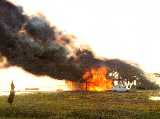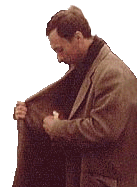I am radically opposed to the way [Sergei] Eisenstein used the frame to codify intellectual formulae. My own method of conveying experience to the audience is quite different... Eisenstein makes thought into a despot: it leaves no "air," nothing of that unspoken elusiveness which is perhaps the most captivating quality of all art...
—Andrei Tarkovsky
The audacity of Tarkovsky's rejection of Eisenstein and his use of rapid editing to create an intellectual and emotional framework by which to understand a film is impressive. It can almost be seen as an attempt to reverse the history of cinema—to begin again, to rub shoulders with such figures from early cinema as D W Griffith and the Lumière brothers. Of course, there are more prosaic political grounds for a rejection of Eisenstein, not least the "Stalinist" Aleksandr Nevsky (1938).
But there were aesthetic grounds, too. Eisenstein had shaped cinema in a very literary way. The associative montage that came to be termed "Eisensteinian" was, for Tarkovsky, that of the novel: the cut juxtaposes images and creates meaning, sometimes termed a "third image," although today we might consider it more along "conceptual" lines. The Eisensteinian cut was the novelist's full-stop. Indeed, Eisenstein had found "cinematic" devices in the prose of Dickens—"Dickens has the cinematic sense of 'opticality,' 'shot,' 'close-up' and the distorting expressiveness of some special lenses"—and even went so far as to find a "dissolve" in Dombey and Son.
Reality and massacre
This may have given rise to the Odessa Steps sequence in Bronenosets Potemkin (Battleship Potemkin, 1925), where cut after cut wrests the film away from reality (just how many steps are there?) as it strikes out into an abstract space where image tumbles after image and the film's aesthetic transforms into a revolutionary miasma. But it was, for Tarkovsky, despotic, a mistaken reading of cinema—of the essence of cinema. In his book Sculpting in Time, Tarkovsky notes:
The idea of "montage cinema"—that editing brings together two concepts and thus engenders a new, third one—again seems to me to be incompatible with the nature of cinema. Art can never have the interplay of concepts as its ultimate goal. The image is tied to the concrete and the material, yet reaches out along mysterious paths to regions beyond the spirit...
The fracturing of time in Eisenstein's cut is rejected by Tarkovsky through the device of the long take. There are almost too many to mention in Tarkovsky's films. In Nostalghia (1983), Andrei Gortchakov, played by Oleg Yankovsky, attempts to cross a drained spa while clutching a lighting candle. It blows out in a slight breeze, and he returns to the beginning, re-lights the candle, touches the wall and begins again. And again. Tarkovsky tracks with him for an agonising eight minutes, back and forth, discreetly moving in to concentrate on the face or for the final close-up of the candle, protected from the wind by his hand.
The speed of the tracking is of the utmost importance here; its slowness strips the camera movement of a narrative function, since the camera movement does not advance the narrative progression of the film in this long take. So what does this slowness do to the aesthetic? Having removed it from the context of the film's narrative, it reworks it as a meditative, perhaps hallucinatory, swell of mobile imagery. The energy of the flame against the wet, green walls of the spa; the aloneness of Andrei; the quiet force of the wind; the dripping of water. It is an existential moment in the film and an equivalent existential gesture on Tarkovsky's part, the speed of this tracking shot. When the journey is complete, Andrei collapses and dies, and it comes as no surprise.
Reality under interrogation
There is a comparably Eisensteinian revolutionary force at work here. The long take was, for French film theorist André Bazin, a way of presenting a segment of life, of laying life bare before the camera. Bazin compared it to a suspect under police interrogation: eventually the suspect will crack and reveal the truth if questioned long enough. Likewise, if the camera is left running long enough, eventually reality will crack and surrender itself to the camera, and the camera can capture this reality accordingly.
The first association of the Tarkovsky long take, therefore, is with Bazin. But something is amiss. Bazin's example was Robert Flaherty, the great documentary maker, and his film Nanook of the North (1922). It was Flaherty's Eskimo waiting for seal that graced Flaherty's long take: Flaherty makes the viewer wait as the Eskimo waits for the seal.
Flaherty... confines himself to showing the actual waiting period; the length of the hunt is the very substance of the image, its true object.
But what were Tarkovsky's credentials as a documentary-maker? Entirely heretical. There are two kinds of filmmakers, Tarkovsky noted: those that reflect the world they see around them (the majority, but Tarkovsky cited Fellini and Bergman, "these are usually the poets") and those that create a world

|
Such moments in Tarkovsky's films—and Tarkovsky's cinema is a cinema of moments of catharsis for those who watch his films—are situated within the "reality effect" of the long take, within the real-time that pulses through the frame. Unlike Flaherty, Tarkovsky does not document, nor does he reflect in the manner of the poets of cinema. He creates, yet in doing this, he uses the device par excellence of the former two rejected categories: the long take.
Agony and catharsis
Nostalghia was a film by an exile: Tarkovsky in Italy, feeling his way through a new landscape, a new iconography and history. The love-hate relationship with the West, being surrounded by the West (a constant theme towards the end of his diaries, Time Within Time) translates into a film from the Russian-Italian border. The final shot, a three-minute long take, is an image of operatic incongruity: "the Russian house inside the Italian Cathedral." Maybe it is along this border that Nostalghia's Andrei, also a temporarily exiled Russian, walks with his candle. Does he walk on behalf of Tarkovsky?
Much as I avoid autobiographical readings of film, I allowed the thought to be suspended in my mind and found myself watching Michal Leszczylowski's documentary on the making of Offret (The Sacrifice, 1986), Directed By Andrei Tarkovsky.
 There is an extraordinary sequence of agony and catharsis towards the end of the documentary. The house constructed to be incinerated for the apocalyptic ending of the film burns beautifully. Our vantage point is now that of the lowly crew member—we look on at the bonfire but can also see Tarkovsky and crew (and those tracks for the tracking shot) as the sequence is filmed.
There is an extraordinary sequence of agony and catharsis towards the end of the documentary. The house constructed to be incinerated for the apocalyptic ending of the film burns beautifully. Our vantage point is now that of the lowly crew member—we look on at the bonfire but can also see Tarkovsky and crew (and those tracks for the tracking shot) as the sequence is filmed.
It is, in some moments, Leszczylowski's long take of Tarkovsky's long take. And then disaster: Tarkovsky's camera has jammed—there was nothing that could be done: reality had yielded itself up for Tarkovsky, but the mechanics of cinema had failed him. Perhaps it serves as a reminder of the unwelcome aspect of the company of Griffith and the Lumières and the "primitives" of cinema.
Tarkovsky is stunned, he covers his eyes with his hands and, after a few involuntary comments ("Why didn't you tell me?", "That's how good we are," "The last thing I expected was a foul-up by the camera crew."), is mute. So, we learn, the house is laboriously re-built and three days later, miraculously, the camera is again ready to roll in front of a fresh house.
Once again, the house is ignited and the world begins to end. It is a tracking shot and a long take, other-worldly, absurd and nightmarish, and committed successfully to celluloid. And achieved: the film is a wrap, the crew embrace and joke—there is a sense of palpable relief. And a second collapse and death for the other Andrei, unseen, after this final long take: Andrei Tarkovsky died later that year on 29 December 1986.
Benjamin Halligan, 13 November 2000
Videography:
Buy Eisenstein's Bronenosets Potemkin
(Battleship Potemkin, 1925)
Buy Tarkovsky's Nostalghia (1983)
Buy Tarkvosky's Offret (The Sacrifice, 1986)
Bibliography:
Bazin, André, "The Evolution of Film Language" in What Is Cinema?: Volume 1; University of California Press, Berkeley, London 1967
- Buy this book
from Amazon.com or from Amazon.co.uk
Eisenstein, S M, "Dickens, Griffith and Ourselves" in Selected Works: Volume III: Writings, 1934-47; British Film Institute, London 1996
- Buy this book
from Amazon.com or from Amazon.co.uk
Tarkovsky, Andrei, "The Artist's Responsibility" and "Time, Rhythm and Editing" in Sculpting in Time: Reflections on the Cinema; The Bodley Head, London 1986
- Buy this book
from Amazon.com or from Amazon.co.uk
Tarkovsky, Andrei, Time Within Time; Faber and Faber, London 1994
- Buy this book
from Amazon.com or from Amazon.co.uk
Moving on:
- The Kinoeye Archive of articles on Central and East European film
- Browse through the CER eBookstore for electronic books
- Buy English-subtitled CEE films on VHS through CER
- Buy English-language books on cinema through CER
- Return to CER front page



